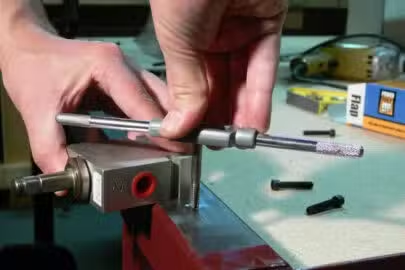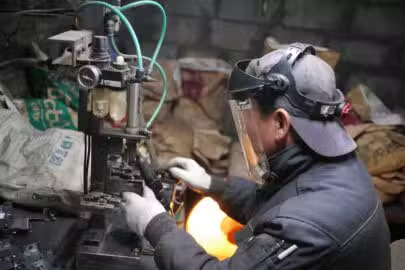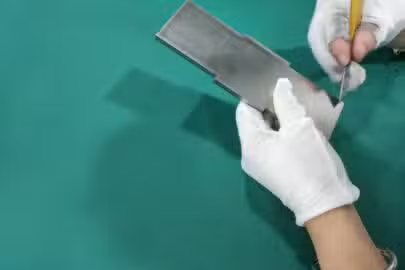Within manufacturing, choosing the most suitable production method is a critical determinant of the ultimate success of your projects. To make this decision confidently, it is essential to possess a comprehensive understanding of the capabilities, advantages, and limitations inherent to various manufacturing technologies.
Machining and Sheet Metal Fabrication stand out as two time-tested and widely utilized manufacturing technologies, each with its own set of unique features and benefits that cater to a broad spectrum of industries and applications. These two methods are highly versatile and have shaped numerous sectors, from automotive and aerospace to electronics and architecture.
In this article, you will learn the distinctions between Machining and Sheet Metal Fabrication, aiding you in selecting the optimal manufacturing technology for your components or goods.
What is CNC Machining and Types of Machining?
Machining is a precise way of shaping metal and other materials by removing excess material using cutting tools, discs, and abrasive wheels. It’s like sculpting but with metal. This method is handy for turning raw materials like flats, bars, and welded or cast parts into specific shapes. It’s commonly used in making car parts, drill bits, plaques, nuts, bolts, and more, which are used across many industries.
Now, here are the various types of machining.
Types of CNC Machining
The machining process can be executed through various methods, encompassing multiple machining techniques. The different types of machining include the following:
Turning
Turning is like a lathe operation where a stationary cutting tool shapes a rotating workpiece. It’s commonly used for producing cylindrical and conical shapes. Turning is essential for crafting parts like shafts, pins, and couplings in various industries, including automotive and aerospace. It’s particularly effective for creating symmetrical components.
Milling
Milling employs rotating cutters to remove material from the workpiece, providing versatility in shaping flat and contoured surfaces. This technique is crucial for producing parts with intricate shapes and details, such as gears and molds. It has two types, which include face milling and slab milling. Face milling creates smooth surfaces, while slab milling is used for larger flat areas.
Drilling
Drilling uses drill bits to create cylindrical holes in materials, making it a fundamental machining process. Drilling is the first step in creating holes for bolts, screws, and other fasteners. It’s also essential for generating holes for different machining processes like tapping and reaming.
Grinding
Grinding improves the surface finish and tightens tolerances on machined parts through abrasive materials. Grinding is essential in producing exact components, including those used in aerospace, medical devices, and precision engineering. It’s often a precursor to finishing operations like honing and lapping.
What is a Sheet Metal Fabrication?
Sheet metal fabrication is a precise process that transforms thin flat sheets generally less than 20mm of steel or aluminum into various metal structures and products. This transformation is achieved through cutting, bending, punching, stamping, welding, and meticulous assembly. Sheet metal’s inherent versatility allows it to be cut, bent or stretched into nearly any desired shape, primarily accomplished through cutting and controlled burning techniques.
In the sheet metal fabrication process, specialized tools such as bands and chop saws are crucial in ensuring consistent and even cutting throughout the entire operation. Cutting torches are exceptionally efficient in cutting large sheet metal sections with minimal effort.
To facilitate the creation of sharp bends and angles within the metal, sheet metal fabricators employ press brakes. These machines come in various types, each serving specific functions and purposes in the fabrication process. The materials used in sheet metal fabrication commonly include Aluminum, Steel, Stainless Steel, Copper, and Brass, enabling the creation of a broad spectrum of metal components.
Materials Used in Sheet Metal Fabrication
The choice of materials is a critical factor in ensuring the success of your sheet metal fabrication project. This section discusses some of the most suitable materials for sheet metal fabrication. It’s important to note that there exists a wide array of sheet metal types, and it’s advisable to seek guidance from a professional like Zintilon before making any final decisions. Here are some of the highly recommended materials:
Aluminum
Aluminum stands as one of the most used materials in sheet metal fabrication. It is renowned for its lightweight nature, impressive strength, and corrosion resistance. Moreover, it offers ease of workability, enabling the creation of a diverse range of products.
Stainless Steel
Stainless steel holds a prominent place in sheet metal fabrication choices. Its strength and durability render it ideal for a multitude of applications. This material boasts resistance against corrosion and exhibits ease of manipulation.
Carbon Steel
Carbon steel, a steel variant enriched with carbon, ranks among the most prevalent materials employed by sheet metal fabricators. Its physical and structural attributes, such as strength, flexibility, and hardness, make it a prime choice for demanding, heavy-duty projects.
Copper
Copper is a malleable metal known for its ease of manipulation. It boasts excellent resistance to both corrosion and heat. Fabricated parts made from copper are often utilized in electrical applications, benefiting from their high conductivity.
Brass
Brass, an alloy comprising copper and zinc, embodies strength, flexibility, and durability. This combination renders brass a perfect selection for a broad spectrum of metal fabrication projects. It is extensively employed in the development of fabricated parts for various industries.
Common Processes in Sheet Metal Fabrication
Sheet metal fabrication involves well-defined processes to transform flat metal sheets into desired shapes and structures. Each process serves a distinct purpose and contributes to creating complex components and products. Here are the most common sheet metal fabrication processes:
Stamping
Stamping is a prevalent and fundamental fabrication process in sheet metal. It entails using a press to push a tool or die through the material, effectively shaping it, much like a cookie cutter. Stamping is an integral part of fabricating sheet metal hardware parts and is frequently combined with other processes to produce the final product.
Punching
Punching is a process employed to create holes or perforations in the source material. A powerful press punches holes in the metal, leaving the final product as the remaining material where the holes were created. This process is akin to stamping but differs in its outcome.
Pressing
Sheet metal press brake machines are invaluable in industries that demand precision sheet metal bending. In sectors like automotive, aerospace, and construction, these machines produce complex shapes with remarkable accuracy. The availability of both manual and automated versions caters to a wide range of manufacturing needs, optimizing production times and enhancing the precision of sheet metal components.
Forming
Forming is a broad term encompassing various techniques for manipulating sheet metal into specific shapes. Bending, rolling, drawing, and stretching are all techniques employed during forming. The original material transforms without any material addition or removal, often achieved through stamping and forming processes.
Bending
Bending involves adding basic angles or curves to the metal, converting linear pieces into dynamic shapes, often resulting in ‘U’ or ‘V’ shapes. This process is cost-effective due to the simplicity of designs and typically requires minimal tooling.
Welding
Welding is a mechanical joining process that uses pressure and heat to fuse two or more metal sections. Common welding types include Tungsten Inert Gas (TIG), Metal Inert Gas (MIG), and Stick Welding. Each method has its specific advantages and applications.
Laser Cutting
Laser cutting employs amplified laser light to cut sheet metal precisely. It is efficient and causes minimal damage to the material, making it ideal for small or intricate parts.
Plasma Cutting
Like laser cutting, plasma cutting uses high-heat plasma to cut the workpiece. It’s cost-effective but may leave slag on the cut edges, necessitating post-cut cleaning.
Waterjet Cutting
Waterjet cutting utilizes an ultra-high-pressure jet of water to cut material. It’s versatile, suitable for various materials, and eco-friendly, producing no heat or harmful debris.
These processes collectively form the foundation of sheet metal fabrication, enabling the creation of a wide range of components and products.
The Key Differences Between Machining and Sheet Metal Fabrication
The choice between machining vs. sheet metal fabrication depends on material type, part complexity, production volume, lead time, and cost considerations. Both processes have their strengths and are valuable in manufacturing and engineering, but selecting the suitable method for a specific project is crucial for achieving optimal results and cost-efficiency. Here are the key differences between machining vs. sheet metal fabrication:
Material Used
Machining: Machining primarily involves removing material from a solid workpiece to achieve the desired shape or dimensions. It is commonly used for a wide range of materials, including metals, plastics, and composites. This process can be applied to various materials, depending on the specific project requirements.
Sheet Metal Fabrication: Sheet metal fabrication, on the other hand, specifically focuses on working with thin metal sheets, such as steel, aluminum, and copper. The process involves cutting, bending, and assembling these thin sheets to create various components and products. It is a specialized technique for metalworking.
Equipment and Machinery
Machining: Machining operations typically employ various machine tools, such as lathes, milling, and drilling machines. These tools are designed to remove material through cutting, turning, or drilling processes. Precision and accuracy are crucial in machining.
Sheet Metal Fabrication: Sheet metal fabrication utilizes equipment like shears, press brakes, and punch presses. These machines are tailored explicitly for cutting, bending, and forming sheet metal. Precision in these processes is equally important for achieving desired shapes and angles.
Finished Product
Machining: The finished machining products are often individual parts with intricate shapes and tight tolerances. Machining is commonly used to create components like gears, shafts, and custom tooling. The final products are typically three-dimensional and can have complex geometries.
Sheet Metal Fabrication: Sheet metal fabrication produces products that are typically two-dimensional or formed into specific shapes, such as enclosures, brackets, panels, and ductwork. These products are often used in construction, automotive, and HVAC systems. The focus is on creating flat or formed components from sheet metal.
Process Complexity
Machining: Machining processes are typically more complex and involve many operations, including turning, milling, drilling, and grinding. These processes require careful planning and precision to achieve the desired results. Machining is well-suited for creating custom, intricate parts with complex geometries.
Sheet Metal Fabrication: Sheet metal fabrication processes are generally less complex than machining. They involve simpler operations such as cutting, bending, welding, and assembling. While precision is still essential, the nature of sheet metal work lends itself to more standardized and repetitive tasks, making it suitable for mass production of similar components.
Material Wastage
Machining: Machining often generates more material wastage, especially when creating intricate parts from a solid block or bar of material. The process removes excess material to shape the final product, which can result in significant waste, especially when working with expensive materials.
Sheet Metal Fabrication: Sheet metal fabrication tends to be more material-efficient. Since it starts with thin metal sheets and uses cutting and bending techniques to form components, there is less material wastage than machining. This can lead to cost savings, especially when working with expensive metals.
Cost Considerations
Machining: Machining is generally more expensive, particularly for complex and custom components, due to the precision and time involved. It can be cost-effective for low to medium-volume production but may become prohibitive for high-volume manufacturing.
Sheet Metal Fabrication: Sheet metal fabrication tends to be more cost-effective, especially for high-volume production. The efficient use of materials, shorter lead times, and the ability to automate processes make it an economical choice for producing standardized sheet metal components.
| Feature | Sheet Metal Fabrication | Machining |
| Tooling and Setup | Minimal tooling is required for many processes | Varied tooling setups for different operations |
| Material Removal | Material remains intact and reshaped | Material is removed during the process |
| Industry Applications | Construction, HVAC, appliances, electronics | Aerospace, automotive, precision engineering |
| Finished Products | Complex structures, parts with contours | Intricate, high-precision components |
| Processes | Stamping, forming, bending, punching, shearing, welding, cutting | Turning, milling, drilling, grinding, honing, lathing |
| Precision | Suited for complex structures and shapes | Ideal for high-precision tasks |
| Primary Process | Manipulating flat metal sheets into desired shapes and structures | Removing material to create parts or components |
When to Use Machining vs. Sheet Metal Fabrication
The use of machining or sheet metal fabrication depends on the specific requirements of a project. Machining suits applications that demand high precision, low to medium volumes, and intricate designs. Sheet metal fabrication is a cost-effective choice for high-volume production, where precision requirements are not as stringent, and the design is more practical.
High Tolerances and Precision
Machining: Machining is the preferred choice when exceptionally high tolerances and precision are paramount. It excels in producing intricate and custom components with extremely tight tolerances. Machining processes like milling, turning, and grinding allow for fine adjustments and precise control over dimensions. It is ideal for applications in aerospace, medical devices, and high-precision tooling where even micrometer-level accuracy is necessary.
Sheet Metal Fabrication: Sheet metal fabrication is less suitable for applications demanding high tolerances and precision. While it can achieve good accuracy, it may not meet the stringent requirements of some industries. Standard tolerances typically characterize sheet metal components and are better suited for applications where sub-millimeter precision is acceptable.
Volume Production
Machining: Machining is typically chosen for low to medium-volume production. While it can produce exact components, the time and cost associated with machining processes make it less economical for large-scale production. It is ideal for prototypes, small batches, or custom parts.
Sheet Metal Fabrication: Sheet metal fabrication excels in high-volume production scenarios. The efficiency of automated cutting, bending, and welding processes, combined with minimal material wastage, makes it cost-effective for producing a large quantity of standardized components. This makes it suitable for industries like automotive, HVAC, and appliance manufacturing.
Aesthetics and Design
Machining: Machining provides greater flexibility for intricate and artistic designs. It allows for creating aesthetically pleasing components with complex shapes and fine surface finishes. This makes it a preferred choice for projects where the appearance and design of the part are critical, such as custom automotive parts or architectural elements.
Sheet Metal Fabrication: Sheet metal fabrication, while capable of producing visually appealing components, is more limited in design complexity compared to machining. It creates functional, practical designs like enclosures, brackets, and panels. Sheet metal parts can be aesthetically pleasing but may not offer the same design freedom as machining for highly detailed or artistic components.
Rapid Prototyping
Machining: Machining is a valuable tool for rapid prototyping when a small quantity of exact prototypes or test components is needed. It allows for quick iterations and adjustments in the early stages of product development.
Sheet Metal Fabrication: Sheet metal fabrication can also be used for rapid prototyping, especially if the final product is made from sheet metal. It allows for the creation of functional prototypes, although they may not reach the same level of precision as machined prototypes.
Conclusion
The difference between machining and sheet metal fabrication lies in their unique strengths and applications. The decision between both manufacturing processes is essential to assess the specific needs of your project, including precision requirements, material type, volume of production, and budget constraints. Understanding these nuances is crucial for selecting the most suitable manufacturing process.
To achieve a successful project using either of these manufacturing processes, you will need to engage with experts in the field to help you make informed decisions. At Zintilon, we take pride in providing high-quality sheet metal fabrication and machining services all in one place. Contact us now to begin your journey to a successful project completion.
FAQs
- What is the key difference between machining and sheet metal fabrication?
Machining is a subtractive manufacturing process that removes material to create parts or components. In contrast, sheet metal fabrication is a process involving the manipulation of flat metal sheets into desired shapes and structures.
- How does the choice of materials differ between machining and sheet metal fabrication?
In machining, a wide range of materials, including metals, plastics, and composites, can be used. In sheet metal fabrication, the focus is primarily on flat metal sheets, such as steel, aluminum, stainless steel, copper, and brass.
- What industries commonly utilize machining, and sheet metal fabrication?
Machining is widely used in industries like aerospace, automotive, and precision engineering. Sheet metal fabrication finds applications in construction, HVAC, appliances, and electronics, among others.
Read More
- What’s Sheet Metal Fabrication-Everything You Need to Know About Sheet Metal Fabrication – Zintilon
- Sheet Metal Fabrication: Understanding the Process – Zintilon
- Sheet Metal Bending: A Complete Guide – Zintilon
- Laser Cutting Steel: Everything You Need to Know – Zintilon
- Understanding CNC Machining: A Guide to Common CNC Machine Types and Their Uses – Zintilon



